Swinburne University MKT20019 Research Brief: WIL Program Analysis
VerifiedAdded on 2022/12/30
|7
|1879
|23
Report
AI Summary
This research brief, created for the MKT20019 Marketing Research course at Swinburne University, analyzes the challenges faced by the Work-Integrated Learning (WIL) program in attracting student participation. The executive summary highlights the need for increased awareness of the WIL program. The background section outlines the program's purpose and the diminishing student interest, attributing it to factors like lack of internship interest and lower pay. The marketing problem focuses on developing effective promotional plans to increase student enrollment. The research objectives aim to understand factors influencing student awareness and participation in the WIL course. The research questions delve into the factors impacting awareness, student interest, and methods to improve participation. The brief concludes by emphasizing the importance of the research in enhancing student engagement and the program's overall success. The report includes references to support the analysis.
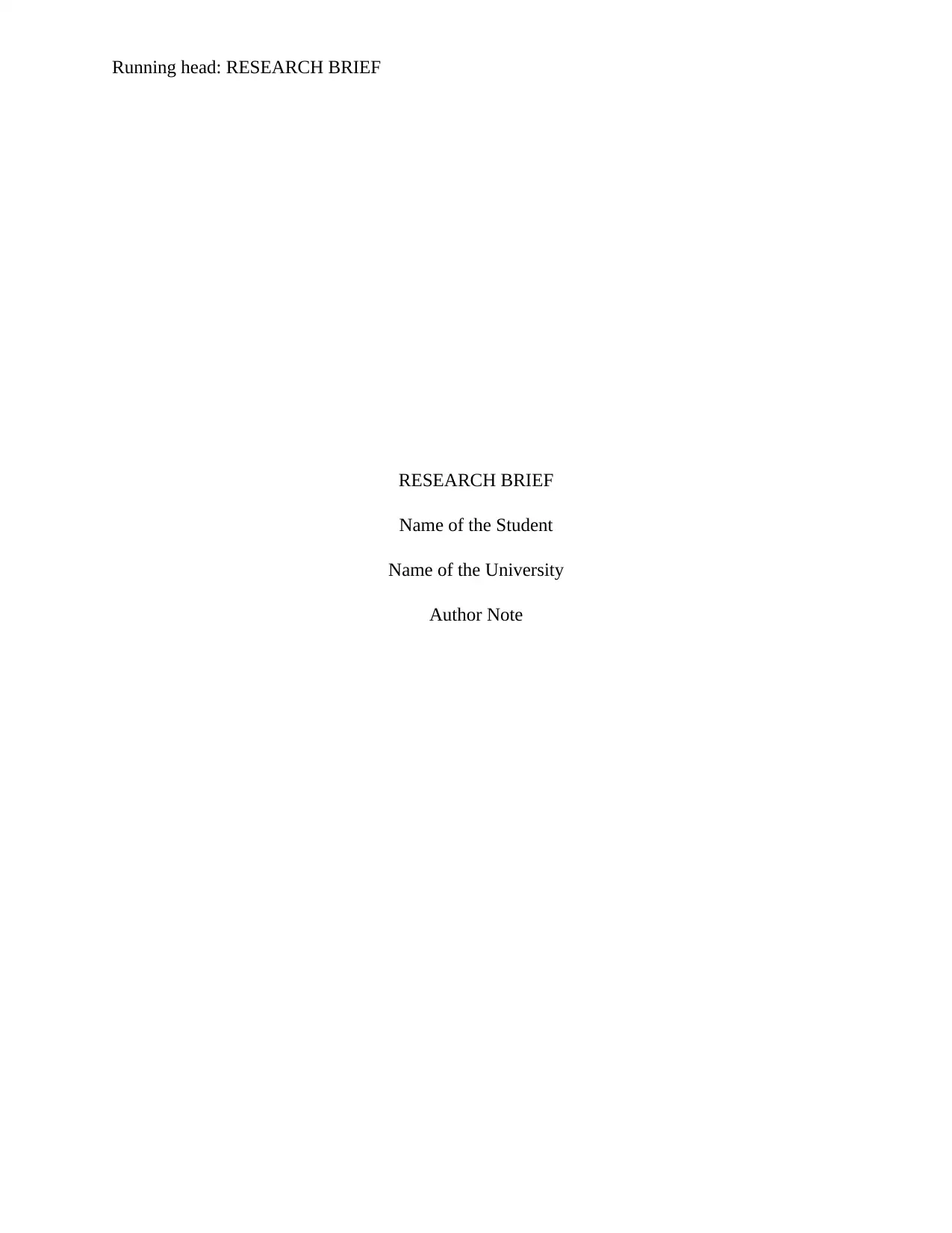
Running head: RESEARCH BRIEF
RESEARCH BRIEF
Name of the Student
Name of the University
Author Note
RESEARCH BRIEF
Name of the Student
Name of the University
Author Note
Paraphrase This Document
Need a fresh take? Get an instant paraphrase of this document with our AI Paraphraser
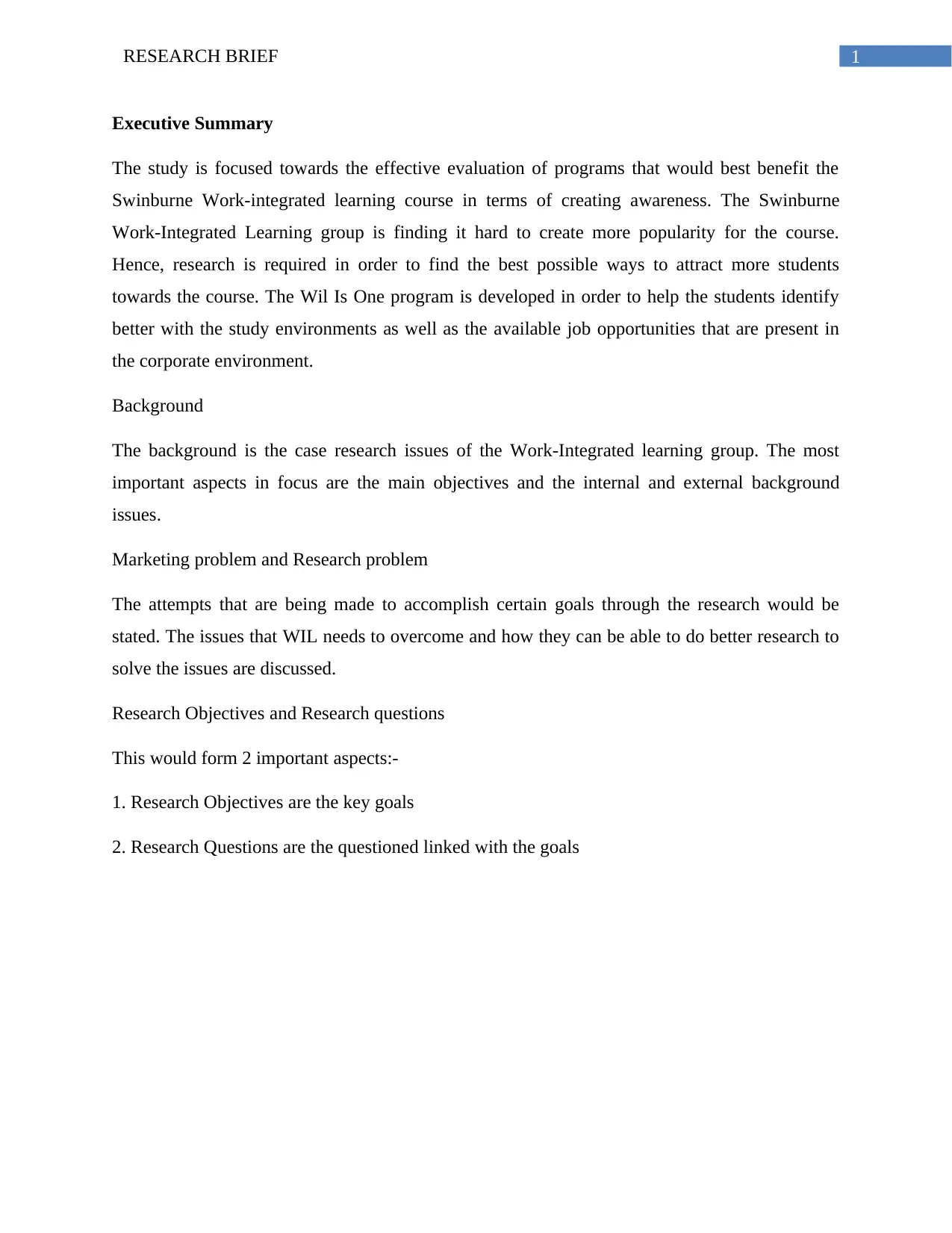
1RESEARCH BRIEF
Executive Summary
The study is focused towards the effective evaluation of programs that would best benefit the
Swinburne Work-integrated learning course in terms of creating awareness. The Swinburne
Work-Integrated Learning group is finding it hard to create more popularity for the course.
Hence, research is required in order to find the best possible ways to attract more students
towards the course. The Wil Is One program is developed in order to help the students identify
better with the study environments as well as the available job opportunities that are present in
the corporate environment.
Background
The background is the case research issues of the Work-Integrated learning group. The most
important aspects in focus are the main objectives and the internal and external background
issues.
Marketing problem and Research problem
The attempts that are being made to accomplish certain goals through the research would be
stated. The issues that WIL needs to overcome and how they can be able to do better research to
solve the issues are discussed.
Research Objectives and Research questions
This would form 2 important aspects:-
1. Research Objectives are the key goals
2. Research Questions are the questioned linked with the goals
Executive Summary
The study is focused towards the effective evaluation of programs that would best benefit the
Swinburne Work-integrated learning course in terms of creating awareness. The Swinburne
Work-Integrated Learning group is finding it hard to create more popularity for the course.
Hence, research is required in order to find the best possible ways to attract more students
towards the course. The Wil Is One program is developed in order to help the students identify
better with the study environments as well as the available job opportunities that are present in
the corporate environment.
Background
The background is the case research issues of the Work-Integrated learning group. The most
important aspects in focus are the main objectives and the internal and external background
issues.
Marketing problem and Research problem
The attempts that are being made to accomplish certain goals through the research would be
stated. The issues that WIL needs to overcome and how they can be able to do better research to
solve the issues are discussed.
Research Objectives and Research questions
This would form 2 important aspects:-
1. Research Objectives are the key goals
2. Research Questions are the questioned linked with the goals
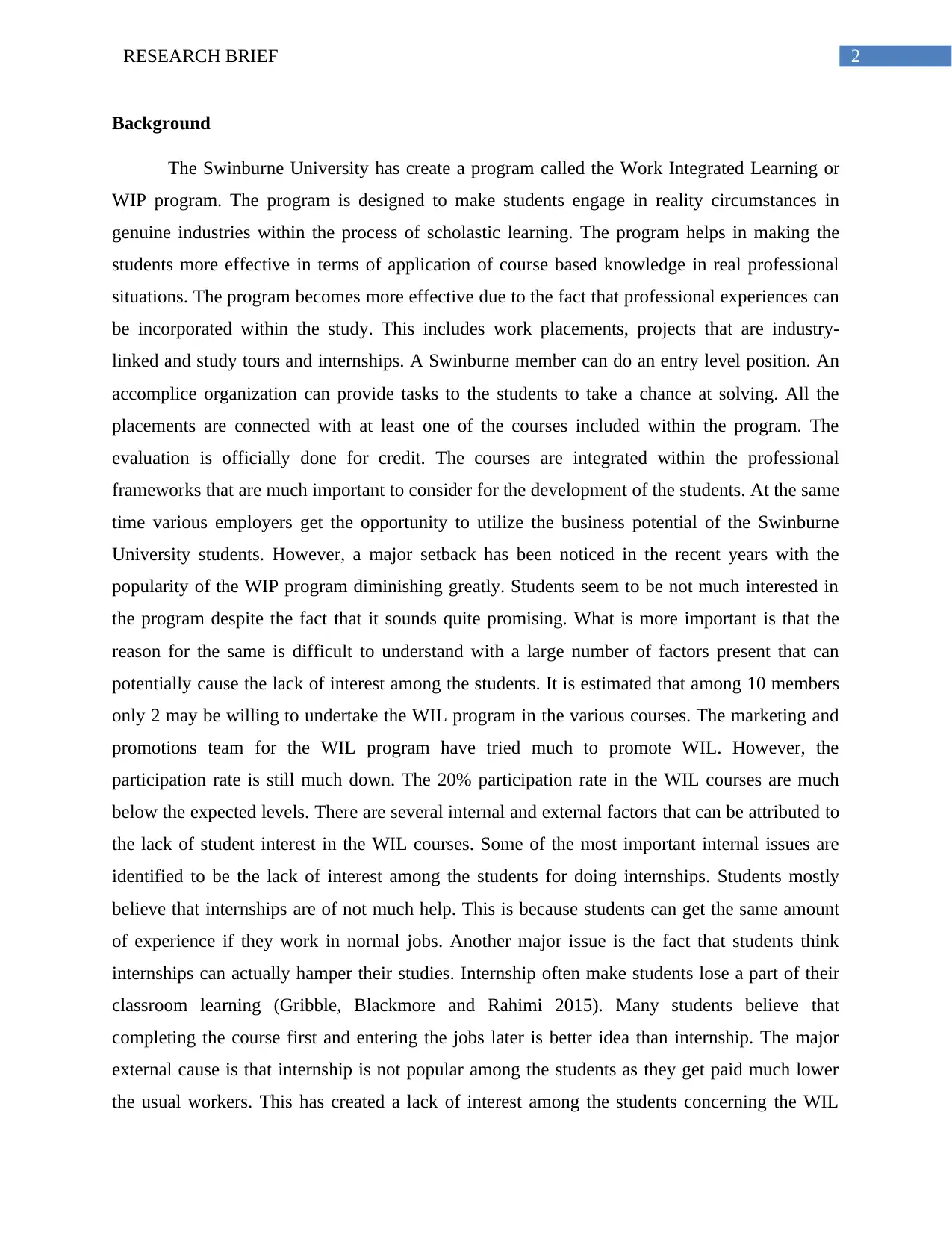
2RESEARCH BRIEF
Background
The Swinburne University has create a program called the Work Integrated Learning or
WIP program. The program is designed to make students engage in reality circumstances in
genuine industries within the process of scholastic learning. The program helps in making the
students more effective in terms of application of course based knowledge in real professional
situations. The program becomes more effective due to the fact that professional experiences can
be incorporated within the study. This includes work placements, projects that are industry-
linked and study tours and internships. A Swinburne member can do an entry level position. An
accomplice organization can provide tasks to the students to take a chance at solving. All the
placements are connected with at least one of the courses included within the program. The
evaluation is officially done for credit. The courses are integrated within the professional
frameworks that are much important to consider for the development of the students. At the same
time various employers get the opportunity to utilize the business potential of the Swinburne
University students. However, a major setback has been noticed in the recent years with the
popularity of the WIP program diminishing greatly. Students seem to be not much interested in
the program despite the fact that it sounds quite promising. What is more important is that the
reason for the same is difficult to understand with a large number of factors present that can
potentially cause the lack of interest among the students. It is estimated that among 10 members
only 2 may be willing to undertake the WIL program in the various courses. The marketing and
promotions team for the WIL program have tried much to promote WIL. However, the
participation rate is still much down. The 20% participation rate in the WIL courses are much
below the expected levels. There are several internal and external factors that can be attributed to
the lack of student interest in the WIL courses. Some of the most important internal issues are
identified to be the lack of interest among the students for doing internships. Students mostly
believe that internships are of not much help. This is because students can get the same amount
of experience if they work in normal jobs. Another major issue is the fact that students think
internships can actually hamper their studies. Internship often make students lose a part of their
classroom learning (Gribble, Blackmore and Rahimi 2015). Many students believe that
completing the course first and entering the jobs later is better idea than internship. The major
external cause is that internship is not popular among the students as they get paid much lower
the usual workers. This has created a lack of interest among the students concerning the WIL
Background
The Swinburne University has create a program called the Work Integrated Learning or
WIP program. The program is designed to make students engage in reality circumstances in
genuine industries within the process of scholastic learning. The program helps in making the
students more effective in terms of application of course based knowledge in real professional
situations. The program becomes more effective due to the fact that professional experiences can
be incorporated within the study. This includes work placements, projects that are industry-
linked and study tours and internships. A Swinburne member can do an entry level position. An
accomplice organization can provide tasks to the students to take a chance at solving. All the
placements are connected with at least one of the courses included within the program. The
evaluation is officially done for credit. The courses are integrated within the professional
frameworks that are much important to consider for the development of the students. At the same
time various employers get the opportunity to utilize the business potential of the Swinburne
University students. However, a major setback has been noticed in the recent years with the
popularity of the WIP program diminishing greatly. Students seem to be not much interested in
the program despite the fact that it sounds quite promising. What is more important is that the
reason for the same is difficult to understand with a large number of factors present that can
potentially cause the lack of interest among the students. It is estimated that among 10 members
only 2 may be willing to undertake the WIL program in the various courses. The marketing and
promotions team for the WIL program have tried much to promote WIL. However, the
participation rate is still much down. The 20% participation rate in the WIL courses are much
below the expected levels. There are several internal and external factors that can be attributed to
the lack of student interest in the WIL courses. Some of the most important internal issues are
identified to be the lack of interest among the students for doing internships. Students mostly
believe that internships are of not much help. This is because students can get the same amount
of experience if they work in normal jobs. Another major issue is the fact that students think
internships can actually hamper their studies. Internship often make students lose a part of their
classroom learning (Gribble, Blackmore and Rahimi 2015). Many students believe that
completing the course first and entering the jobs later is better idea than internship. The major
external cause is that internship is not popular among the students as they get paid much lower
the usual workers. This has created a lack of interest among the students concerning the WIL
⊘ This is a preview!⊘
Do you want full access?
Subscribe today to unlock all pages.

Trusted by 1+ million students worldwide
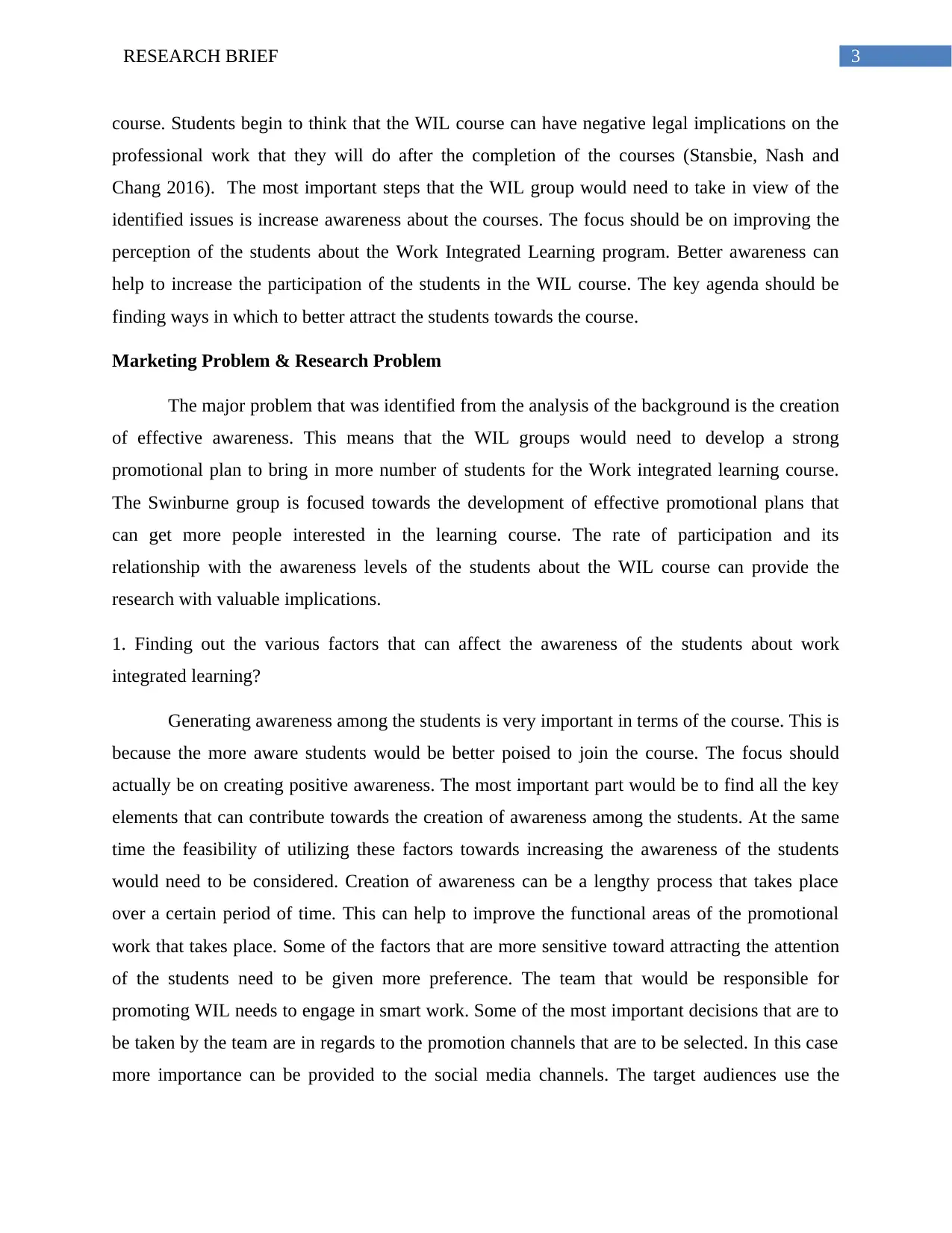
3RESEARCH BRIEF
course. Students begin to think that the WIL course can have negative legal implications on the
professional work that they will do after the completion of the courses (Stansbie, Nash and
Chang 2016). The most important steps that the WIL group would need to take in view of the
identified issues is increase awareness about the courses. The focus should be on improving the
perception of the students about the Work Integrated Learning program. Better awareness can
help to increase the participation of the students in the WIL course. The key agenda should be
finding ways in which to better attract the students towards the course.
Marketing Problem & Research Problem
The major problem that was identified from the analysis of the background is the creation
of effective awareness. This means that the WIL groups would need to develop a strong
promotional plan to bring in more number of students for the Work integrated learning course.
The Swinburne group is focused towards the development of effective promotional plans that
can get more people interested in the learning course. The rate of participation and its
relationship with the awareness levels of the students about the WIL course can provide the
research with valuable implications.
1. Finding out the various factors that can affect the awareness of the students about work
integrated learning?
Generating awareness among the students is very important in terms of the course. This is
because the more aware students would be better poised to join the course. The focus should
actually be on creating positive awareness. The most important part would be to find all the key
elements that can contribute towards the creation of awareness among the students. At the same
time the feasibility of utilizing these factors towards increasing the awareness of the students
would need to be considered. Creation of awareness can be a lengthy process that takes place
over a certain period of time. This can help to improve the functional areas of the promotional
work that takes place. Some of the factors that are more sensitive toward attracting the attention
of the students need to be given more preference. The team that would be responsible for
promoting WIL needs to engage in smart work. Some of the most important decisions that are to
be taken by the team are in regards to the promotion channels that are to be selected. In this case
more importance can be provided to the social media channels. The target audiences use the
course. Students begin to think that the WIL course can have negative legal implications on the
professional work that they will do after the completion of the courses (Stansbie, Nash and
Chang 2016). The most important steps that the WIL group would need to take in view of the
identified issues is increase awareness about the courses. The focus should be on improving the
perception of the students about the Work Integrated Learning program. Better awareness can
help to increase the participation of the students in the WIL course. The key agenda should be
finding ways in which to better attract the students towards the course.
Marketing Problem & Research Problem
The major problem that was identified from the analysis of the background is the creation
of effective awareness. This means that the WIL groups would need to develop a strong
promotional plan to bring in more number of students for the Work integrated learning course.
The Swinburne group is focused towards the development of effective promotional plans that
can get more people interested in the learning course. The rate of participation and its
relationship with the awareness levels of the students about the WIL course can provide the
research with valuable implications.
1. Finding out the various factors that can affect the awareness of the students about work
integrated learning?
Generating awareness among the students is very important in terms of the course. This is
because the more aware students would be better poised to join the course. The focus should
actually be on creating positive awareness. The most important part would be to find all the key
elements that can contribute towards the creation of awareness among the students. At the same
time the feasibility of utilizing these factors towards increasing the awareness of the students
would need to be considered. Creation of awareness can be a lengthy process that takes place
over a certain period of time. This can help to improve the functional areas of the promotional
work that takes place. Some of the factors that are more sensitive toward attracting the attention
of the students need to be given more preference. The team that would be responsible for
promoting WIL needs to engage in smart work. Some of the most important decisions that are to
be taken by the team are in regards to the promotion channels that are to be selected. In this case
more importance can be provided to the social media channels. The target audiences use the
Paraphrase This Document
Need a fresh take? Get an instant paraphrase of this document with our AI Paraphraser
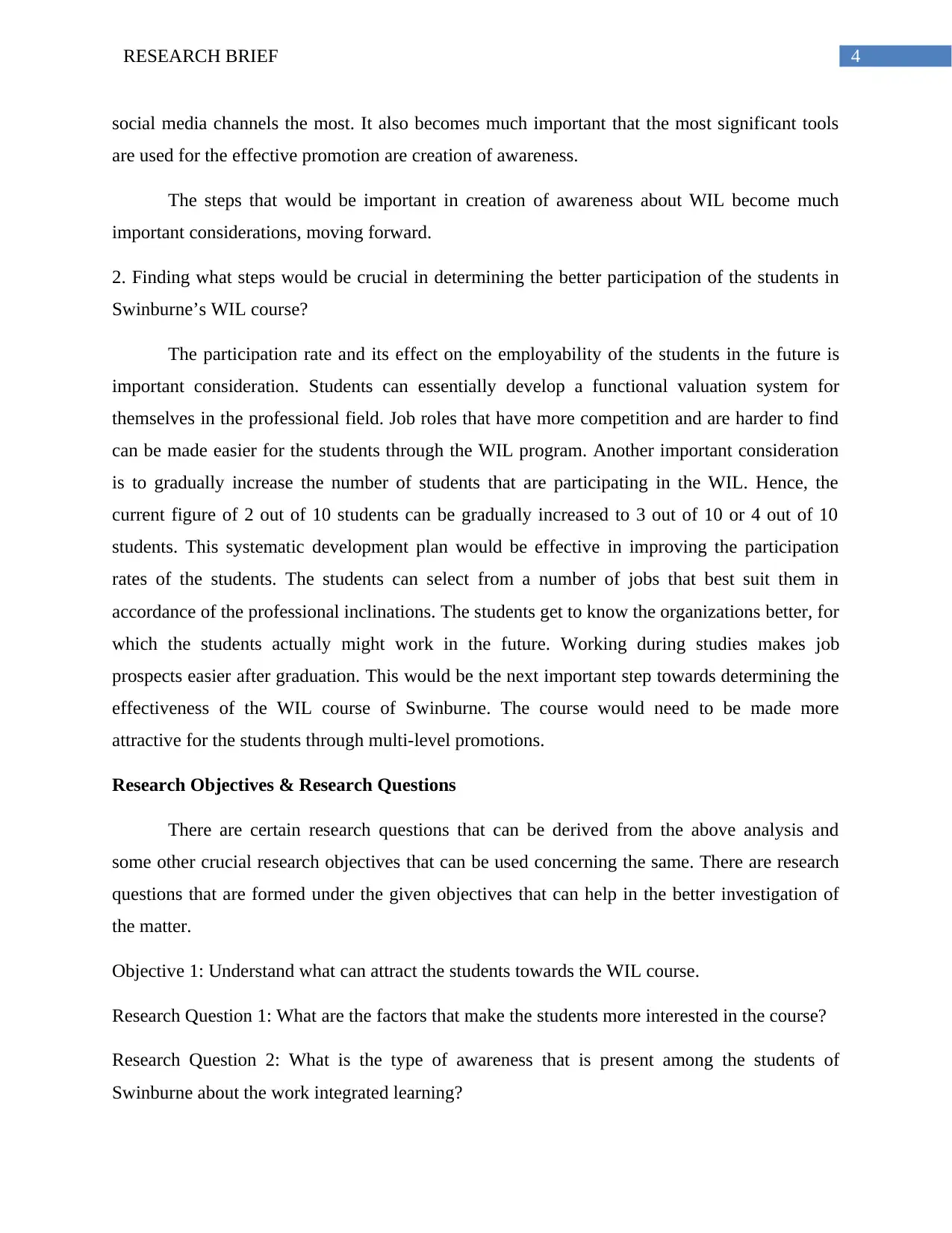
4RESEARCH BRIEF
social media channels the most. It also becomes much important that the most significant tools
are used for the effective promotion are creation of awareness.
The steps that would be important in creation of awareness about WIL become much
important considerations, moving forward.
2. Finding what steps would be crucial in determining the better participation of the students in
Swinburne’s WIL course?
The participation rate and its effect on the employability of the students in the future is
important consideration. Students can essentially develop a functional valuation system for
themselves in the professional field. Job roles that have more competition and are harder to find
can be made easier for the students through the WIL program. Another important consideration
is to gradually increase the number of students that are participating in the WIL. Hence, the
current figure of 2 out of 10 students can be gradually increased to 3 out of 10 or 4 out of 10
students. This systematic development plan would be effective in improving the participation
rates of the students. The students can select from a number of jobs that best suit them in
accordance of the professional inclinations. The students get to know the organizations better, for
which the students actually might work in the future. Working during studies makes job
prospects easier after graduation. This would be the next important step towards determining the
effectiveness of the WIL course of Swinburne. The course would need to be made more
attractive for the students through multi-level promotions.
Research Objectives & Research Questions
There are certain research questions that can be derived from the above analysis and
some other crucial research objectives that can be used concerning the same. There are research
questions that are formed under the given objectives that can help in the better investigation of
the matter.
Objective 1: Understand what can attract the students towards the WIL course.
Research Question 1: What are the factors that make the students more interested in the course?
Research Question 2: What is the type of awareness that is present among the students of
Swinburne about the work integrated learning?
social media channels the most. It also becomes much important that the most significant tools
are used for the effective promotion are creation of awareness.
The steps that would be important in creation of awareness about WIL become much
important considerations, moving forward.
2. Finding what steps would be crucial in determining the better participation of the students in
Swinburne’s WIL course?
The participation rate and its effect on the employability of the students in the future is
important consideration. Students can essentially develop a functional valuation system for
themselves in the professional field. Job roles that have more competition and are harder to find
can be made easier for the students through the WIL program. Another important consideration
is to gradually increase the number of students that are participating in the WIL. Hence, the
current figure of 2 out of 10 students can be gradually increased to 3 out of 10 or 4 out of 10
students. This systematic development plan would be effective in improving the participation
rates of the students. The students can select from a number of jobs that best suit them in
accordance of the professional inclinations. The students get to know the organizations better, for
which the students actually might work in the future. Working during studies makes job
prospects easier after graduation. This would be the next important step towards determining the
effectiveness of the WIL course of Swinburne. The course would need to be made more
attractive for the students through multi-level promotions.
Research Objectives & Research Questions
There are certain research questions that can be derived from the above analysis and
some other crucial research objectives that can be used concerning the same. There are research
questions that are formed under the given objectives that can help in the better investigation of
the matter.
Objective 1: Understand what can attract the students towards the WIL course.
Research Question 1: What are the factors that make the students more interested in the course?
Research Question 2: What is the type of awareness that is present among the students of
Swinburne about the work integrated learning?
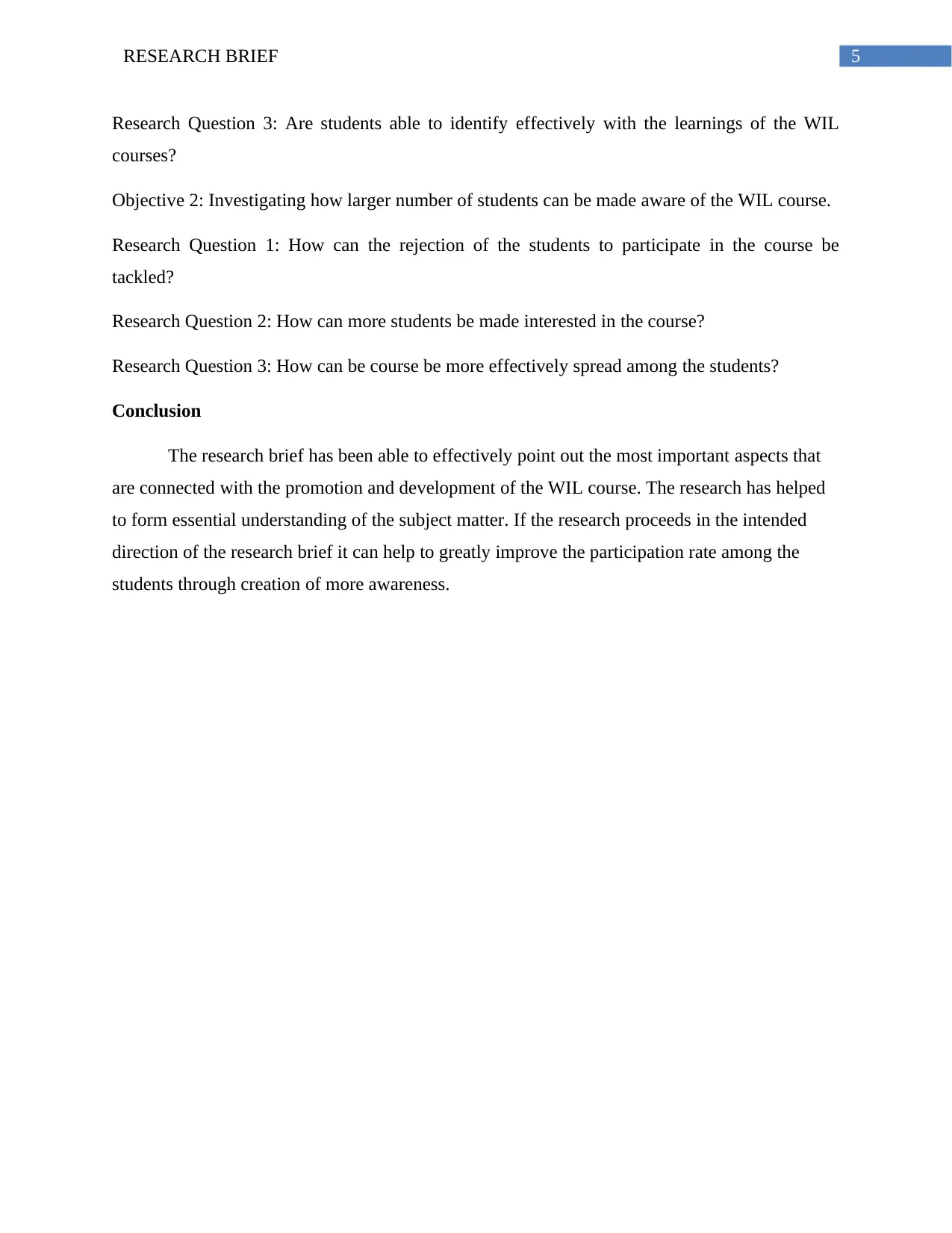
5RESEARCH BRIEF
Research Question 3: Are students able to identify effectively with the learnings of the WIL
courses?
Objective 2: Investigating how larger number of students can be made aware of the WIL course.
Research Question 1: How can the rejection of the students to participate in the course be
tackled?
Research Question 2: How can more students be made interested in the course?
Research Question 3: How can be course be more effectively spread among the students?
Conclusion
The research brief has been able to effectively point out the most important aspects that
are connected with the promotion and development of the WIL course. The research has helped
to form essential understanding of the subject matter. If the research proceeds in the intended
direction of the research brief it can help to greatly improve the participation rate among the
students through creation of more awareness.
Research Question 3: Are students able to identify effectively with the learnings of the WIL
courses?
Objective 2: Investigating how larger number of students can be made aware of the WIL course.
Research Question 1: How can the rejection of the students to participate in the course be
tackled?
Research Question 2: How can more students be made interested in the course?
Research Question 3: How can be course be more effectively spread among the students?
Conclusion
The research brief has been able to effectively point out the most important aspects that
are connected with the promotion and development of the WIL course. The research has helped
to form essential understanding of the subject matter. If the research proceeds in the intended
direction of the research brief it can help to greatly improve the participation rate among the
students through creation of more awareness.
⊘ This is a preview!⊘
Do you want full access?
Subscribe today to unlock all pages.

Trusted by 1+ million students worldwide
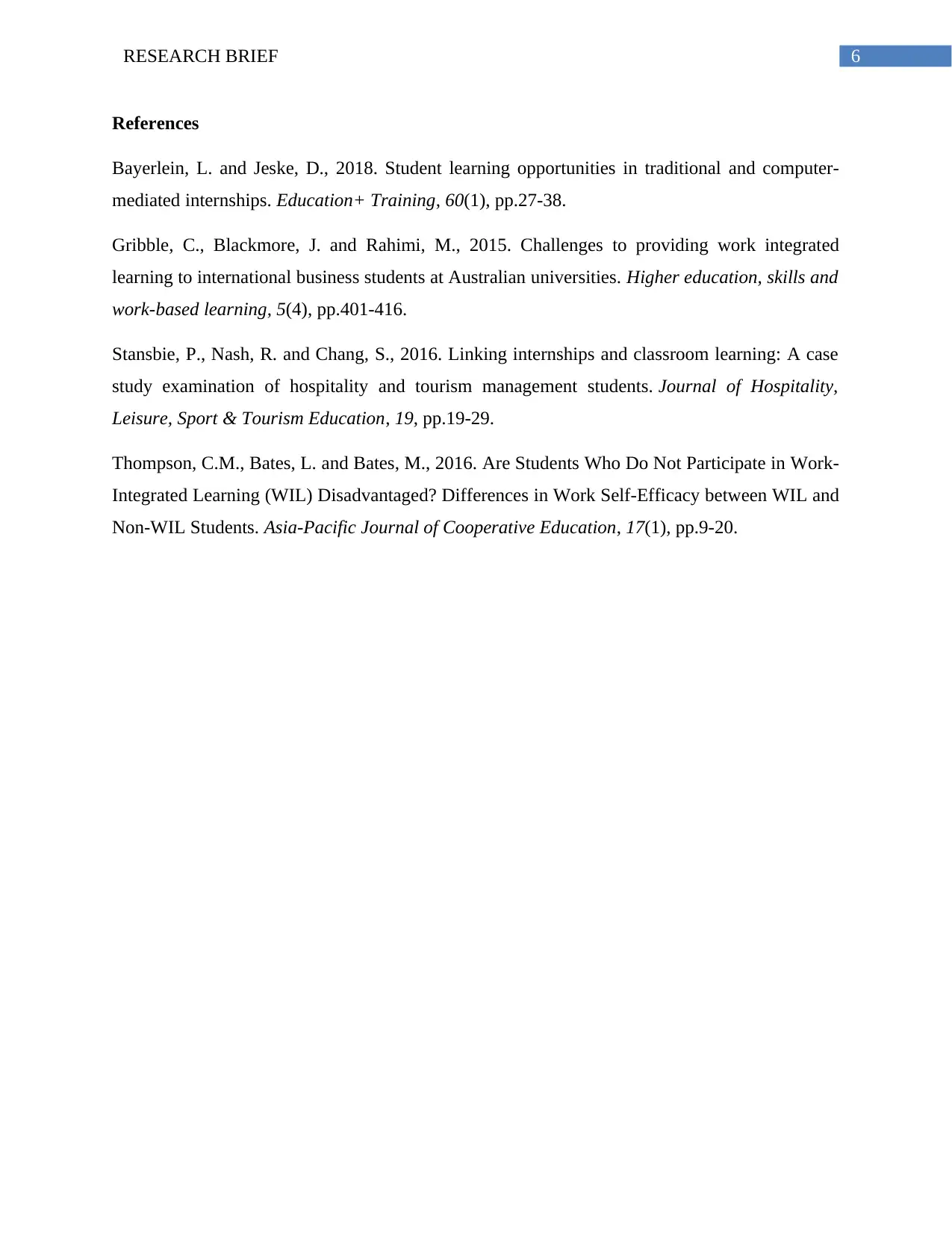
6RESEARCH BRIEF
References
Bayerlein, L. and Jeske, D., 2018. Student learning opportunities in traditional and computer-
mediated internships. Education+ Training, 60(1), pp.27-38.
Gribble, C., Blackmore, J. and Rahimi, M., 2015. Challenges to providing work integrated
learning to international business students at Australian universities. Higher education, skills and
work-based learning, 5(4), pp.401-416.
Stansbie, P., Nash, R. and Chang, S., 2016. Linking internships and classroom learning: A case
study examination of hospitality and tourism management students. Journal of Hospitality,
Leisure, Sport & Tourism Education, 19, pp.19-29.
Thompson, C.M., Bates, L. and Bates, M., 2016. Are Students Who Do Not Participate in Work-
Integrated Learning (WIL) Disadvantaged? Differences in Work Self-Efficacy between WIL and
Non-WIL Students. Asia-Pacific Journal of Cooperative Education, 17(1), pp.9-20.
References
Bayerlein, L. and Jeske, D., 2018. Student learning opportunities in traditional and computer-
mediated internships. Education+ Training, 60(1), pp.27-38.
Gribble, C., Blackmore, J. and Rahimi, M., 2015. Challenges to providing work integrated
learning to international business students at Australian universities. Higher education, skills and
work-based learning, 5(4), pp.401-416.
Stansbie, P., Nash, R. and Chang, S., 2016. Linking internships and classroom learning: A case
study examination of hospitality and tourism management students. Journal of Hospitality,
Leisure, Sport & Tourism Education, 19, pp.19-29.
Thompson, C.M., Bates, L. and Bates, M., 2016. Are Students Who Do Not Participate in Work-
Integrated Learning (WIL) Disadvantaged? Differences in Work Self-Efficacy between WIL and
Non-WIL Students. Asia-Pacific Journal of Cooperative Education, 17(1), pp.9-20.
1 out of 7
Related Documents
Your All-in-One AI-Powered Toolkit for Academic Success.
+13062052269
info@desklib.com
Available 24*7 on WhatsApp / Email
![[object Object]](/_next/static/media/star-bottom.7253800d.svg)
Unlock your academic potential
Copyright © 2020–2025 A2Z Services. All Rights Reserved. Developed and managed by ZUCOL.





